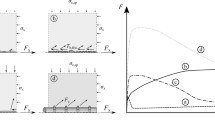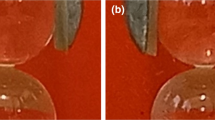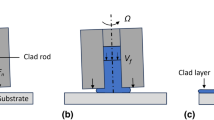Abstract
The interface toughness of adhesively bonded structural members is one of the critical parameters for adhesive joint design. It is often assumed that the joint toughness is a material constant so that its value can be obtained from fracture tests of simple geometries such as DCB for Mode-I, ENF for Mode-II, using linear elastic fracture mechanics (LEFM). However, the LEFM assumption of point-wise crack-tip fracture process is overly simplistic and may cause significant error in interpreting fracture test data. In this paper, the accuracy and applicability of various traditional beam-bending-theory based methods for fracture toughness evaluation, such as simple beam theory (SBT), corrected beam theory (CBT) and experimental compliance method (ECM), were assessed using the cohesive zone modelling (CZM) approach. It was demonstrated that the fracture process zone (FPZ) size has profound influence on toughness calculation and unfortunately, all the classic beam-bending theories based methods fail to include this important element and are erroneous especially when the ratio of crack length to FPZ size is relatively small (<5.0). It has also been demonstrated that after the FPZ size is incorporated into simple beam formulations, they provide much improved evaluation for fracture toughness. Formulation of first order estimate of FPZ size is also given in this paper.
Similar content being viewed by others
References
Blackman, B.R.K., Kinloch, A.J., Paraschi, M., Teo, W.S., 2003. Measuring the Mode I adhesive fracture energy, G IC, of structural adhesive joints: the results of an international round-robin. International Journal of Adhesion & Adhesives, 23(4):293–305. [doi:10.1016/S0143-7496(03)00047-2]
Blackman, B.R.K., Kinloch, A.J., Paraschi, M., 2005. The determination of the Mode II adhesive fracture resistance, G IIC, of structural adhesive joints: an effective crack length approach. Engineering Fracture Mechanics, 72(6):877–897. [doi:10.1016/j.engfracmech.2004.08.007]
Hutchinson, J.W., Suo, Z., 1992. Mixed mode cracking in layered materials. Advances in Applied Mechanics, 29:63–191.
Kanninen, M.F., 1973. An augmented double cantilever beam model for studying crack propagation and arrest. International Journal of Fracture, 9(1):83–92.
Kinloch, A.J., Lau, C.C., Williams, G.J., 1994. The peeling of flexible laminates. International Journal of Fracture, 94:79–88.
Needleman, A., 1987. A continuum model for void nucleation by inclusion debonding. Journal of Applied Mechanics, 54:525–531.
Needleman, A., 1997. Numerical modeling of crack growth under dynamic loading conditions. Computation Mechanics, 19(6):463–469. [doi:10.1007/s004660050194]
Tvergaard, V., Hutchinson, J.W., 1992. The relation between crack growth resistance and fracture process parameters in elastic-plastic solids. Journal of the Mechanics and Physics of Solids, 40(6):1377–1397. [doi:10.1016/00225096(92)90020-3]
Tvergaard, V., Hutchinson, J.W., 1993. The influence of plasticity on the mixed mode interface toughness. Journal of the Mechanics and Physics of Solids, 41(6):1119–1135. [doi:10.1016/0022-5096(93)90057-M]
Williams, J.G., 1989. End corrections for orthotropic DCB specimens. Composite Science and Technology, 35(4):367–376. [doi:10.1016/0266-3538(89)90058-4]
Yang, Q.D., Thouless, M.D., 2001. Mixed-mode fracture analyses of plastically-deforming adhesive joints. International Journal of Fracture, 110(2):175–187. [doi:10.1023/A:1010869706996]
Yang, Q.D., Cox, B.N., 2005. Cohesive models for damage evolution in laminated composites. International Journal of Fracture, 133(2):107–137. [doi:10.1007/s10704-005-4729-6]
Yang, Q.D., Thouless, M.D., Ward, S.M., 1999. Numerical simulation of adhesively-bonded beams failing with extensive plastic deformation. Journal of the Mechanics and Physics of Solids, 47(6):1337–1353. [doi:10.1016/S00225096(98)00101-X]
Yang, Q.D., Thouless, M.D., Ward, S.M., 2000. Analysis of the 90°-peel test with extensive plastic deformation. Journal of Adehesion, 72:115–132.
Yang, Q.D., Cox, B.N., Nalla, R.K., Ritchie, R.O., 2006. Fracture length scales in human cortical bone: the necessity of nonlinear fracture models. Biomaterials, 27(9):2095–2113. [doi:10.1016/j.biomaterials.2005.09.040]
Author information
Authors and Affiliations
Corresponding author
Additional information
Project supported by the National Natural Science Foundation of China (No. 10272088), and the Program for New Century Excellent Talents in University, China
Rights and permissions
About this article
Cite this article
Zhou, Zq., Yang, Qd. & Chen, Wq. On the fracture resistance of adhesively jointing structures. J. Zhejiang Univ. - Sci. A 7, 1289–1295 (2006). https://doi.org/10.1631/jzus.2006.A1289
Received:
Accepted:
Published:
Issue Date:
DOI: https://doi.org/10.1631/jzus.2006.A1289




